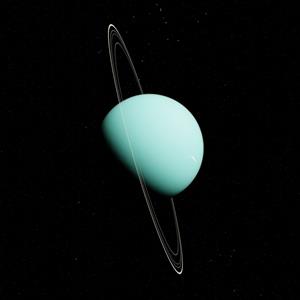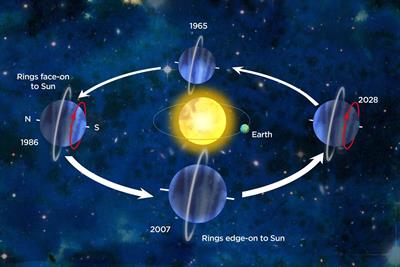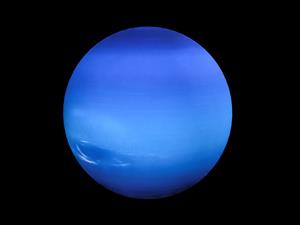
PUMPA - SMART LEARNING
எங்கள் ஆசிரியர்களுடன் 1-ஆன்-1 ஆலோசனை நேரத்தைப் பெறுங்கள். டாப்பர் ஆவதற்கு நாங்கள் பயிற்சி அளிப்போம்
Book Free DemoIn the solar system, the outermost planets are Uranus and Neptune. These two planets are referred to as 'Ice giants'. Uranus and Neptune are near twin in size and surface composition. Large telescopes are used to view these two planets.
Uranus:
The seventh planet, Uranus, appears blue-green. Being the third biggest giant, Uranus is surrounded by \(13\) faint rings with \(27\) natural satellites revolving around it.
Uranus
Unique tilt:
Uranus has a highly tilted rotational axis which makes the orbital motion of the planet appear to spin on its side. This unique tilt makes Uranus appear to orbit the Sun like a rolling ball. Due to this, the planet has the longest summers and winters, each lasting around \(42\ years\). The period of rotation is \(17\ hours\), and the period of revolution is \(84\ years\).

The tilted axis of Uranus
Neptune:
The eighth planet, Neptune, is the farthest in the solar system. This blue planet is the last ice giant made up of hydrogen and helium in liquid form. No life can exist on this dark, cold planet. It is \(3.9\) times larger than the Earth. The period of rotation is \(18\ hours\), and the period of revolution is \(165\ years\).

Neptune
Neptune is the windiest planet, with \(13\) satellites revolving around it. Triton is its largest natural satellite and the only moon in the solar system that orbits in the opposite direction of the planet's spin. Pluto come across Neptune's orbit for \(20\ years\) out of every \(248\ years\).
The ninth planet - Pluto:
Pluto was considered the ninth planet in the solar system until \(2006\). In \(2006\), the International Astronomical Union (IAU) framed a new definition and conditions for a celestial object to be a planet. Since Plutodoes not satisfy those criteria of a planet, the Union announced it is no longer a planet.
Reference:
https://live.staticflickr.com/7268/13598076553_054e90b934_b.jpg